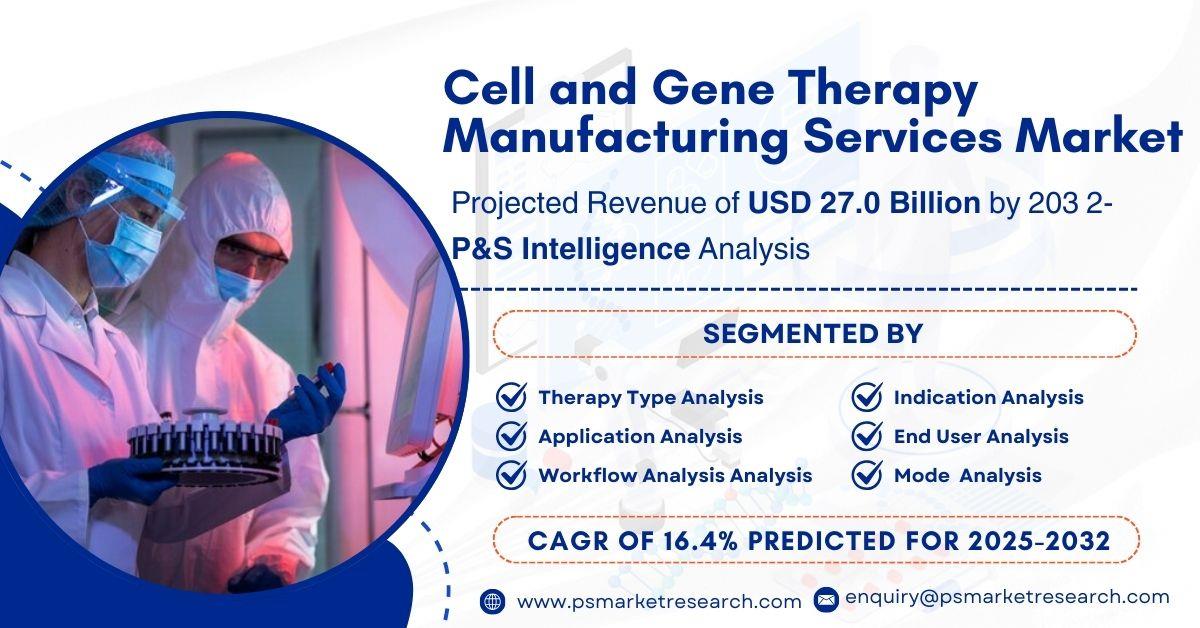Science
Cell and Gene Therapy Market Expected to Reach $27 Billion by 2032

The global market for cell and gene therapy (CGT) manufacturing services is on track for significant expansion, projected to grow from USD 8.1 billion in 2024 to a remarkable USD 27 billion by 2032. According to a recent market research study by P&S Intelligence, this growth reflects a compound annual growth rate (CAGR) of 16.4%. The surge is driven by an increase in clinical trials, more regulatory approvals, and heightened investments in personalized medicine, marking a pivotal shift in advanced therapeutic development.
The rising incidence of cancer and genetic disorders globally is reshaping treatment strategies. The World Health Organization reported nearly 10 million cancer-related deaths in 2020, highlighting the urgent need for innovative CGT solutions. As biopharmaceutical companies turn to specialized contract development and manufacturing organizations (CDMOs) to manage complex production processes, the market is witnessing advancements in viral vector production, cell culture optimization, and scalable bioprocessing technologies.
Key Market Drivers Fueling Expansion
One of the primary factors contributing to market growth is the increasing trend of outsourcing. Currently, over 65% of CGT manufacturing is outsourced, compared to approximately 35% for traditional biologics. Small biotechnology firms, which account for two-thirds of innovation in this sector, rely on CDMOs to expedite time-to-market while benefiting from specialized infrastructure and regulatory knowledge.
The expanding clinical pipeline is another significant driver. With more than 1,975 clinical trials currently underway worldwide—including 360 CAR-T focused trials—the demand for both clinical and commercial manufacturing capabilities is escalating, particularly in oncology and emerging central nervous system (CNS) therapies. Supportive regulatory frameworks, including expedited approval pathways and initiatives like the U.S. Cell and Gene Therapy Access Model, are further encouraging investments in manufacturing infrastructure.
Market Segmentation Insights
The CGT manufacturing market is segmented by therapy type, indication, application, mode, workflow, and end users. In terms of therapy type, cell therapies lead the market with 65% of the share, while gene therapies are anticipated to grow the fastest due to advancements in viral vector production and recent breakthrough approvals.
Cancer remains the predominant indication, comprising 55% of the market, with CNS disorders presenting the fastest growth due to innovations in gene editing technologies and the pressing need for effective treatments. Commercial manufacturing currently dominates with 75% of the market, yet clinical manufacturing is witnessing rapid growth, driven by an expanding early-phase trial pipeline.
Contract manufacturing holds a commanding 70% market share, although in-house capabilities are increasing as larger pharmaceutical firms invest more in internal production capacities. Among the workflow segments, process development is the largest, while vector production is the fastest growing, reflecting heightened demand for gene therapy manufacturing.
Pharmaceutical and biotechnology companies comprise 55% of the market share, with academic and research institutions emerging as a growing force in early-stage development.
Regional Market Dynamics
Regionally, North America leads the global CGT manufacturing market with a share of 45% in 2024, driven by a high concentration of biotechnology firms, advanced R&D capabilities, and strong government support. The U.S. market is projected to grow at a CAGR of 17.1% through 2032.
Conversely, the Asia-Pacific region is expected to record the fastest growth, with a CAGR of 17.5%. This increase is supported by rising investments, regulatory reforms, and strategic partnerships, positioning countries like China, Japan, and India as significant players in the market.
The competitive landscape of the CGT manufacturing sector is moderately consolidated, with major players including Lonza Group Ltd., Catalent Inc., Thermo Fisher Scientific, WuXi AppTec, and Oxford Biomedica plc, collectively controlling approximately 70% of the market. These companies are investing heavily in facility expansions, platform technologies, and strategic collaborations to meet the increasing demand for complex therapies.
Recent industry developments illustrate this momentum. In September 2024, ScaleReady USA and Bio-Techne launched optimized ProPak GMP Cytokines aimed at enhancing cell and gene therapy manufacturing efficiency. In July 2024, Genezen Laboratories expanded its strategic manufacturing capacity by acquiring uniQure’s commercial gene therapy operations. Additionally, December 2023 marked significant milestones with FDA approvals for bluebird bio’s Lyfgenia and Vertex’s Casgevy, both of which are cell-based gene therapies targeting sickle cell disease.
As clinical pipelines grow and regulatory approvals accelerate, the CGT manufacturing services market is poised for unprecedented growth. This evolving landscape is set to redefine the future of personalized medicine and advanced therapeutics on a global scale.
-

 Lifestyle4 months ago
Lifestyle4 months agoHumanism Camp Engages 250 Youths in Summer Fest 2025
-

 Business5 months ago
Business5 months agoKenvue Dismisses CEO Thibaut Mongon as Strategic Review Advances
-

 Sports4 months ago
Sports4 months agoDe Minaur Triumphs at Washington Open After Thrilling Comeback
-

 Sports5 months ago
Sports5 months agoTupou and Daugunu Join First Nations Squad for Lions Clash
-

 Top Stories5 months ago
Top Stories5 months agoColombian Senator Miguel Uribe Shows Signs of Recovery After Attack
-

 World5 months ago
World5 months agoASEAN Gears Up for Historic Joint Meeting of Foreign and Economic Ministers
-

 Health4 months ago
Health4 months agoNew Study Challenges Assumptions About Aging and Inflammation
-

 Business5 months ago
Business5 months agoOil Prices Surge Following New EU Sanctions on Russia
-

 Entertainment4 months ago
Entertainment4 months agoDetaşe-Sabah Violin Ensemble Captivates at Gabala Music Festival
-

 Entertainment4 months ago
Entertainment4 months agoBaku Metro Extends Hours for Justin Timberlake Concert
-

 Top Stories5 months ago
Top Stories5 months agoRethinking Singapore’s F&B Regulations Amid Business Closures
-

 Business5 months ago
Business5 months agoU.S. House Approves Stablecoin Bill, Sends to Trump for Signature









